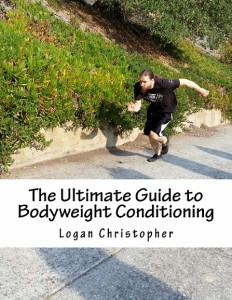The following is an excerpt from The Ultimate Guide to Bodyweight Conditioning.
In the training world you’ve likely come across these terms before: strength, strength-endurance and endurance. What is the difference in these? What makes something a feat of strength versus a feat of endurance? You may think of deadlifting a heavy barbell as a feat of strength. And a marathon would be a feat of endurance. And you would be correct. But how would you classify 50 burpees? Strength or endurance? Or is that where the term strength-endurance comes in?
There is a whole spectrum in between the end points of absolute strength and absolute endurance. All these points in between will require some strength and some endurance. How much of what will depend on the exercise and task at hand. It is not black and white as many people try to force fit it. Instead it is a gradual curve.
 The important point is that you’ll need to focus on those different points in this strength-endurance spectrum. You want to be doing things that work strength and endurance at the same time. There will be times when you do things on the ends of the curve as pure strength or endurance, but most work will be somewhere in between.
The important point is that you’ll need to focus on those different points in this strength-endurance spectrum. You want to be doing things that work strength and endurance at the same time. There will be times when you do things on the ends of the curve as pure strength or endurance, but most work will be somewhere in between.
Focusing on Strength Based Exercises
For the majority of conditioning exercise it is great to focus on having the strength component with it. When you are doing exercises that have a tremendous cardio taxing ability to it, and at the same time also straining the muscles, you are pushing the body to its limits. You are working the body in its entirety.
If you are doing an exercise that is merely taxing your cardio then you are lacking an important piece and not fully working the body. You aren’t getting the full benefit behind it. This goes along with working your anaerobic capacity as mentioned before. A light jog simply cannot test those energy pathways due to lack of intensity. The reason it lacks intensity is the muscles don’t work all that much.
When we get to the exercises you’ll see that many combine the strength along with the cardio. The best exercises will always do this. And if you really want to separate the most intense exercises from those that aren’t this is one test it must pass.
However, in order to push your conditioning levels you can’t go too far in the strength side of the curve. If you do that you will just be testing your strength levels. Once your strength gives out you’d still have a reserve of conditioning left and may not necessarily train that aspect sufficiently enough.
You have to play around in this spectrum in order to push different areas at different times. This will function to raise up your strength and conditioning at the same time.
As an example, take the bodyweight squat, an excellent exercise. If a beginner starts on these, they may find them hard in a variety of ways. A large portion of the population has ‘forgotten’ how to use these muscles and lacks the flexibility to do full squats. But beyond that when they start with this exercise, the weakness in strength of the leg muscles is often going to give out first. After a few reps the legs burn too much and they can’t do anymore.
Later on as they get more experience, and it doesn’t take too much, a bodyweight squat isn’t the most difficult of exercises. So they push up their numbers. And they can get to a point where it’s the breathing that stops them, not the muscular fatigue.
Much further on, at a certain pace and tempo its seems that you can go on forever. It is neither taxing enough strength or cardio wise. Having done one thousand Hindu squats I’ve experienced this. That was a great goal to hit at that time, but if I want to continue to raise my strength and conditioning I’d have to look elsewhere, to in some way up the intensity of that exercise or do something different. Continuing to add reps won’t really make me any stronger or better conditioned.
By manipulating the weight, leverage, style and many other aspects you can take more strength or endurance and find the right mix for you. This is why you will need a multi-prong approach to build never quit conditioning.
Want more? Click here to grab the full book.

